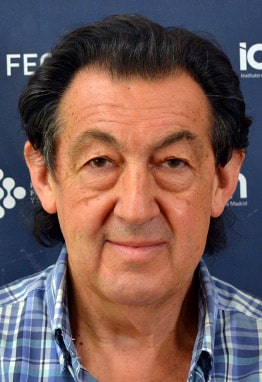
The guideline of my research activity has been the interaction of the light with matter. It included the use of optical spectroscopy (1980-2021), holographic data storing (1986-1994), scintillators (1990-1995), pulsed laser deposited (PLD) of ferro/piezoelectric materials (1993-2005), photovoltaic materials (Si 2005-2010, & perovskite 2019-), modelocked femtosecond solid state lasers (SSL, 2004-2021) and luminescent nanoprobes (NP, 2009-2021).
I have installed at ICMM-CSIC several laboratories for PLD deposition of thin films, bulk crystal growth by Czochralski (CZ) and Top Seeded Solution Growth (TSSG) methods, and a laboratory for optical spectroscopies and laser demonstrations. I have supervised 9 PhD works, one of them (J. A. Álvarez Pérez, 2021) within the last ten years, 3 Master works, and 5 long stays of foreing research visitors.
I had been IP of an EU funded project (STREP. NMP3-CT-2003-505580), and 14 more funded by national institutions. I have participated in other further 14 projects with other IPs. I carried out three contracts with national photovoltaic companies (BP-Solar, ENSOL & ISOFOTON, 2001-2007) and developed two knowledge-transfer oriented projects with Spanish laser companies (EASY LASER & JEANOLOGY/FYLA, 2011-2018). According the CSIC data base overall these project rose 2.9 millions of euros.
I actively cooperate with the Centro de Láseres Pulsados Ultrarrápidos y Ultraintensos (CLPU) in Salamanca and I established a ICMM-CLPU Cooperation Agreement (2014-2019). I cooperated worldwide with many different laboratories (maybe more than 50). Just to mention a few in the last ten years: Unv. Aveiro, ILL-Grenoble, Inst. Low Temperature in Wroclaw, Centre for Optical Materials in Minsk, Lab Physique de la Mat. Condensée, Palaiseau, Max Born Int. Nonlinear Optics & Short pulse spectroscopy, Berlin, Unv. Coimbra, Korea Adv. Nanofabrication Center, Inst. Laser Physik, Hamburg, U.S. Army Res lab., etc….and with the laser crystal manufacturer Electro-Optics Technology in Idar-Oberstein.
I coauthored 216 peer reviewed papers, 2 book chapters, and contributed to more than 200 Conferences. These contributions received >4700 citations, with average of 22 cites per work and h= 41.
In the last years I have contributed in the developing, understanding and demonstration of the merits of “disordered” single crystals as laser hosts to produce very short laser pulses (duration<100 fs). Most modelocked SSLs are based in the broadband luminescence of d electrons (Ti3+, d1) but its potential for power scaling is little because required pumping is in the visible with associated large quantum-defect (heat transfer to the host). Lanthanides (Ln, 4f electrons) can be diode pumped with very low quantum defect but have very narrow bandwidth (no or little tunable capability). However, the Crystal Field on the Ln can be spatially modulated by introducing disorder in the crystal lattice at the local level, i. e. two or more different (size and charge) cations sitting in the same crystallographic sites. I pioneered the use of double tungstates (DW), NaLn(WO4)2, and double molybdates (DMo), NaLn(MoO4)2, as femtosecond lasers and later I substantially improved the understanding of the physical and laser properties of Ca3(NbGa)5O12 (CNGG) single crystal garnets. I have been the first to show that Na+ in the Ca2+ (dodecahedral) site acts as size and charge compensation of Yb3+ incorporation in this site. Further, I have shown that Li+ exclusively sits in the garnet tetrahedral site removing vacancies.
Also in the SSL arena, many different disordered oxide crystals melt above >1500 ºC thus Pt crucibles can not be used. Through an international collaboration with Aveiro University, I showed that the crucible-less Laser Floating Zone (LFZ) air growth technique produces oxyorthosilicates with laser capability.
The powerful infrared (800-3000 nm) spectroscopic capabilities installed by me have been used for the determination of the optical response of different materials, including organic LEDs based in β-diketonates molecules and perovskite solar cells, but particular emphasis has been paid in the development of new luminescent NPs with efficient upconversion (UC) properties for imaging and non contact thermometry. It was shown that tetragonal DW & DMo have at 25 ºC an UC efficiency as good as the reference material β-NaYF4 and even better at higher temperatures. These new UCNPs have been synthesized as small diamonds with 5x10 nm size and introduced inside of mesenchymal stem cells (in cooperation with Ramón y Cajal Hospital-Madrid) and perfused in different mouse organs (cooperations with CNB-CSIC and CNIC-ISCIII). Nanostructuring of these UC materials led to the proposal of colour displays by UC and functionalization of PMMA nanotubes.

